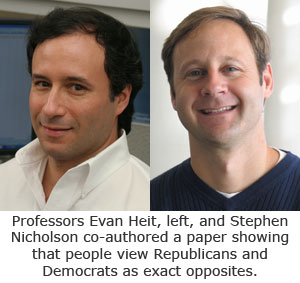

People view Democrats and Republicans, and liberals and conservatives as exact opposites, according to a recently published interdisciplinary study conducted by two UC Merced professors.
The findings, authors
Evan Heitand
Stephen Nicholsonwrote, suggest that the American political system is highly coherent and organized. Elected officials — as members of political parties or ideological backgrounds — offer a distinct choice since a candidate running for office is not typical of both.
“It seems like it’s lonely to be in the middle, politically speaking,” said Heit, a
cognitive scientist. “Politicians can be typical Democrats or typical Republicans, but they can’t be typical of both.”
The article, “The Opposite of Republican: Polarization and Political Categorization,” was published recently online by “Cognitive Science,” the official journal of the Cognitive Science Society. The article will also be included in the upcoming printed edition.
The findings, Heit and Nicholson note, have implications for governance, which often requires compromise and consensus. A Republican proposal could be opposed by Democrats simply because it is viewed as being opposite of what Democrats would do, the paper notes.
“It’s really a new era of politics,” said Nicholson, a
political scientist. “It’s the loss of bipartisan governance. We’re living it today so it’s hard to appreciate how politics were once very different. If we could go back in time to do this study, I wouldn’t expect to see such extreme polarization.”
What was surprising to the authors was the extremeness of the results. Even with other categories that are opposite pairs like male jobs and female jobs, some jobs are considered typical for both males and females. Healthy food and junk foods are opposites, but it is possible to be neither a healthy food or a junk food. In comparison, people’s views of politicians were extremely polarized, with no middle ground possible.
Heit and Nicholson in October 2008 surveyed 351 UC Merced students, asking them to rate 15 individuals on the typicality either as a Democrat or as a Republican. They had an option of choosing a number between one and seven, with one being a “very poor example” and seven being a “very good example.”
For example, students were asked how typical former President George W. Bush is of a Republican or of a Democrat. The rating put him as being very typical of a Republican and not very typical of a Democrat. Other people rated in the study included President Barack Obama, former President Bill Clinton, Gov. Arnold Schwarzenegger and former Alaska Gov. Sarah Palin.
The politicians fell neatly along a diagonal line in a highly organized way. None were considered typical of both Democrats and Republicans. The results were measured with a “correlation,” on a 0 to 1 scale. The correlation was 0.9957. Heit said he was “shocked” by this result as it was the strongest finding he had ever seen in years of research.
Such distinct categorization may be fairly recent development, Nicholson noted. For example, he explained, the Democratic Party in 1952 was trying to get Dwight “Ike” Eisenhower to run for president as a Democrat, given his centrist views. Their effort failed, but he won the presidency by a landslide, garnering some votes from Democrats.
In today’s political climate, it’s unimaginable for a candidate to be getting support from both parties, Nicholson said.
Heit and Nicholson plan to continue this research by surveying people across the nation, to get a better sense of the causes of polarization.






